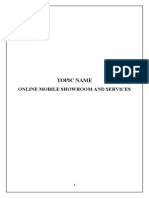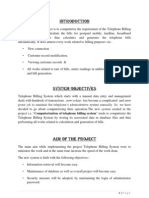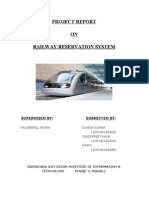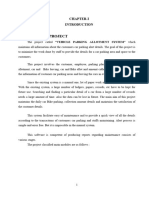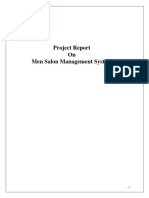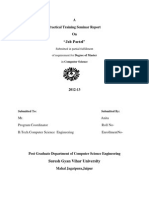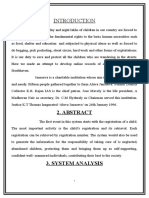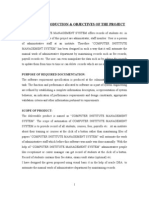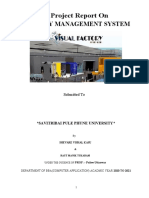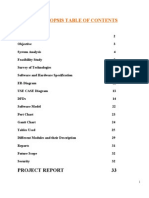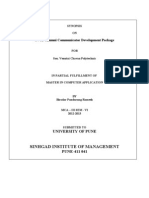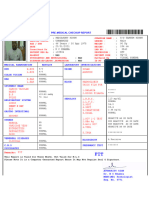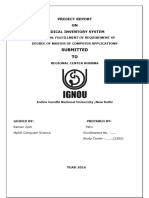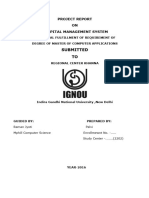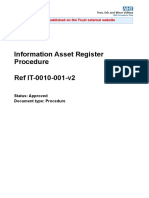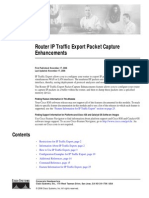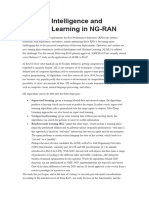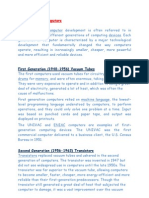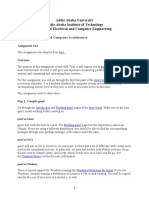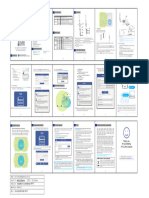Vehicle Stock Computerisation Project File
Uploaded by
Act SujanpurVehicle Stock Computerisation Project File
Uploaded by
Act Sujanpur1
INTRODUCTION TO PROJECT
To provide facility to maintain password and file Identity through a website.
EXISTING SYSTEM
This system “Vehicle services” allows providing vehicle for service. If customer got any
problem with her vehicle based on guarantee card they are providing services. The real power
of this project lies not in direct selling of products, but in the creation of tighter relationships
with customers and delivering of a high level of service and support, which in turn improves
organization sales and its goodwill.
A service organization is a business entity that takes care of servicing a customer instrument
in the after sales domain. As the number of customers and size of operations increases, the
organization divides the geographical area into service areas and branch locations, to allow
Engineers to be more responsive to the customer-needs.
This project also provides all the information of vehicle, vehicle type and vehicle maker.
This application has a good appearance and is very easy to operate. It is very simple and easy
to access at .net. This project contains a lot of advance modules which make the back end
system very powerful.
The Vehicle Stock Computerization (VMS ) is the Proactive management science of using
and maintaining a fleet of vehicles in such a fashion that whilst spending the minimum
amount of money , a Vehicle manager is able to offer her/her users maximum flexibility ,
availability and reliability.
VMS has been developed in conjunction with the Transport Industry in an effort to provide a
total web-based solution for Maintenance, Operational and Administrative Controls in any
vehicle situation.
The competitive nature of our transport world today requires that we manage all aspects of
the transport business. The VMS includes customer’s resources, the vehicles that play an
integral part in delivering your products and services to the customer.
2
SYSTEM ANALYSIS
INTRODUCTION
After analyzing the requirements of the task to be performed, the next step is to analyze the
problem and understand its context. The first activity in the phase is studying the existing system and
other is to understand the requirements and domain of the new system. Both the activities are equally
important, but the first activity serves as a basis of giving the functional specifications and then
successful design of the proposed system. Understanding the properties and requirements of a new
system is more difficult and requires creative thinking and understanding of existing running system
is also difficult, improper understanding of present system can lead diversion from solution.
ANALYSIS MODEL
SDLC METHDOLOGIES
This document play a vital role in the development of life cycle (SDLC) as it describes the
complete requirement of the system. It means for use by developers and will be the basic during
testing phase. Any changes made to the requirements in the future will have to go through formal
change approval process.
SPIRAL MODEL was defined by Barry Bohem in her 1988 article, “A spiral Model of
Software Development and Enhancement. This model was not the first model to discuss iterative
development, but it was the first model to explain why the iteration models.
The steps for Spiral Model can be generalized as follows:
The new system requirements are defined in as much details as possible. This usually
involves interviewing a number of users representing all the external or internal users and
other aspects of the existing system.
A preliminary design is created for the new system.
A first prototype of the new system is constructed from the preliminary design. This is
usually a scaled-down system, and represents an approximation of the characteristics of
the final product.
A second prototype is evolved by a fourfold procedure:
1. Evaluating the first prototype in terms of its strengths, weakness, and risks.
2. Defining the requirements of the second prototype.
3. Planning an designing the second prototype.
4. Constructing and testing the second prototype
3
The existing prototype is evaluated in the same manner as was the previous prototype,
and if necessary, another prototype is developed from it according to the fourfold
procedure outlined above.
The preceding steps are iterated until the customer is satisfied that the refined prototype
represents the final product desired.
The final system is constructed, based on the refined prototype.
The final system is thoroughly evaluated and tested.
The following diagram shows how a spiral model acts like:
4
STUDY OF THE SYSTEM
In the flexibility of the uses the interface has been developed a graphics concept in mind,
associated through a browser interface. The GUI’S at the top level have been categorized as
1. Administrative user interface
2. The operational or generic user interface
The administrative user interface concentrates on the consistent information that is
practically, part of the organizational activities and which needs proper authentication for the data
collection. The interfaces help the administrations with all the transactional states like Data insertion,
Data deletion and Data updating along with the extensive data search capabilities.
The operational or generic user interface helps the users upon the system in transactions
through the existing data and required services. The operational user interface also helps the ordinary
users in managing their own information helps the ordinary users in managing their own information
in a customized manner as per the assisted flexibilities
NUMBER OF MODULES
System Requirement Specifications
Hardware Requirements:
PIV 2.8 GHz Processor and Above
RAM 512MB and Above
HDD 40 GB Hard Disk Space and Above
Software Requirements:
WINDOWS OS 7 / 2000 / 200 Server / 2003 Server)
Visual Studio .Net 2010 Enterprise Edition
Internet Information Server 5.0 (IIS)
Visual Studio .Net Framework (Minimal for Deployment) version 4.0
SQL Server 2008 R2 Enterprise Edition
5
PROPOSED SYSTEM
To debug the existing system, remove procedures those cause data redundancy, make
navigational sequence proper. To provide information about users on different level and also to reflect
the current work status depending on organization. To build strong password mechanism.
NEED FOR COMPUTERIZATION
We all know the importance of computerization. The world is moving ahead at
lightning speed and everyone is running short of time. One always wants to get the information and
perform a task he/she/they desire(s) within a short period of time and too with amount of efficiency
and accuracy. The application areas for the computerization have been selected on the basis of
following factors:
Minimizing the manual records kept at different locations.
There will be more data integrity.
Facilitating desired information display, very quickly, by retrieving information from users.
Facilitating various statistical information which helps in decision-making?
To reduce manual efforts in activities that involved repetitive work.
Updating and deletion of such a huge amount of data will become easier.
FUNCTIONAL FEATURES OF THE MODEL
As far as the project is developed the functionality is simple, the objective of the proposal is
to strengthen the functioning of Audit Status Monitoring and make them effective and better. The
entire scope has been classified into five streams knows as Coordinator Level, Identity Level, Auditor
Level, User Level and State Web Coordinator Level. The proposed software will cover the
information needs with respect to each request of the user group viz. accepting the request, providing
vulnerability document report and the current status of the audit.
INPUT AND OUTPUT
Inputs:
Admin enters credentials.
Admin add states by entering details.
Admin adds Countries.
Admin Approve the user by verifying the registration details
User enters registration details.
User enters credentials.
User Adds the Favorites by entering favorite’s details.
6
User adds the User adds the Passwords by entering password details.
User enter the change password details.
User enter the Edit profile details.
Outputs:
Admin will get her home page.
User can get her favorites list.
User can check the mails.
User will get her home page
User can get her profile.
PROCESS MODEL USED WITH JUSTIFICATION
ACCESS CONTROL FOR DATA WHICH REQUIRE USER AUTHENTICAION
The following commands specify access control identifiers and they are typically used to
authorize and authenticate the user (command codes are shown in parentheses)
USER NAME (USER)
The user identification is that which is required by the server for access to its file system. This
command will normally be the first command transmitted by the user after the control connections are
made (some servers may require this).
PASSWORD (PASS)
This command must be immediately preceded by the user name command, and, for some
sites, completes the user's identification for access control. Since password information is quite
sensitive, it is desirable in general to "mask" it or suppress type out.
Feasibility Report
Preliminary investigation examine project feasibility, the likelihood the system will be useful to the
organization. The main objective of the feasibility study is to test the Technical, Operational and
Economical feasibility for adding new modules and debugging old running system. All system is
feasible if they are unlimited resources and infinite time. There are aspects in the feasibility study
portion of the preliminary investigation:
7
Technical Feasibility
Operational Feasibility
Economical Feasibility
TECHNICAL FEASIBILITY
The technical issue usually raised during the feasibility stage of the investigation includes the
following:
Does the necessary technology exist to do what is suggested?
Do the proposed equipments have the technical capacity to hold the data required to use the new
system?
Will the proposed system provide adequate response to inquiries, regardless of the number or
location of users?
Can the system be upgraded if developed?
Are there technical guarantees of accuracy, reliability, ease of access and data security?
OPERATIONAL FEASIBILITY
Proposed projects are beneficial only if they can be turned out into information system. That
will meet the organization’s operating requirements. Operational feasibility aspects of the project are
to be taken as an important part of the project implementation. Some of the important issues raised are
to test the operational feasibility of a project includes the following: -
Is there sufficient support for the Identity from the users?
Will the system be used and work properly if it is being developed and implemented?
Will there be any resistance from the user that will undermine the possible application benefits?
This system is targeted to be in accordance with the above-mentioned issues. Beforehand, the
Identity issues and user requirements have been taken into consideration. So there is no question of
resistance from the users that can undermine the possible application benefits.
The well-planned design would ensure the optimal utilization of the computer resources and would
help in the improvement of performance status.
ECONOMICAL FEASIBILITY
8
A system can be developed technically and that will be used if installed must still be a good
investment for the organization. In the economical feasibility, the development cost in creating the
system is evaluated against the ultimate benefit derived from the new systems. Financial benefits must
equal or exceed the costs.
The system is economically feasible. It does not require any addition hardware or software.
Since the interface for this system is developed using the existing resources and technologies
available at NIC, There is nominal expenditure and economical feasibility for certain.
9
SOFTWARE REQUIREMENT SPECIFICATION
The software, Site Explorer is designed for Identity of web sites from a remote location.
INTRODUCTION
Purpose: The main purpose for preparing this document is to give a general insight into the analysis
and requirements of the existing system or situation and for determining the operating characteristics
of the system.
Scope: This Document plays a vital role in the development life cycle (SDLC) and it describes the
complete requirement of the system. It is meant for use by the developers and will be the basic during
testing phase. Any changes made to the requirements in the future will have to go through formal
change approval process.
DEVELOPERS RESPONSIBILITIES OVERVIEW:
The developer is responsible for:
Developing the system, which meets the SRS and solving all the requirements of the system?
Demonstrating the system and installing the system at client's location after the acceptance testing
is successful.
Submitting the required user manual describing the system interfaces to work on it and also the
documents of the system.
Conducting any user training that might be needed for using the system.
Maintaining the system for a period of one year after installation.
4.1. FUNCTIONAL REQUIREMENTS
OUTPUT DESIGN
Outputs from computer systems are required primarily to communicate the results of
processing to users. They are also used to provide a permanent copy of the results for later
consultation. The various types of outputs in general are:
External Outputs, whose destination is outside the organization.
Internal Outputs whose destination is within organization and they are the
User’s main interface with the computer.
Operational outputs whose use is purely within the computer department.
10
Interface outputs, which involve the user in communicating directly.
OUTPUT DEFINITION
The outputs should be defined in terms of the following points:
Type of the output
Content of the output
Format of the output
Location of the output
Frequency of the output
Volume of the output
Sequence of the output
It is not always desirable to print or display data as it is held on a computer. It should be
decided as which form of the output is the most suitable.
For Example
Will decimal points need to be inserted
Should leading zeros be suppressed.
11
INPUT DESIGN
Input design is a part of overall system design. The main objective during the input design is
as given below:
To produce a cost-effective method of input.
To achieve the highest possible level of accuracy.
To ensure that the input is acceptable and understood by the user.
INPUT STAGES:
The main input stages can be listed as below:
Data recording
Data transcription
Data conversion
Data verification
Data control
Data transmission
Data validation
Data correction
INPUT TYPES:
It is necessary to determine the various types of inputs. Inputs can be categorized as follows:
External inputs, which are prime inputs for the system.
Internal inputs, which are user communications with the system.
Operational, which are computer department’s communications to the system?
Interactive, which are inputs entered during a dialogue.
Flexibility of format
Speed
Accuracy
Verification methods
Rejection rates
ERROR AVOIDANCE
12
At this stage care is to be taken to ensure that input data remains accurate form the stage at
which it is recorded up to the stage in which the data is accepted by the system. This can be achieved
only by means of careful control each time the data is handled.
ERROR DETECTION
Even though every effort is make to avoid the occurrence of errors, still a small proportion of
errors is always likely to occur, these types of errors can be discovered by using validations to check
the input data.
DATA VALIDATION
Procedures are designed to detect errors in data at a lower level of detail. Data validations
have been included in the system in almost every area where there is a possibility for the user to
commit errors. The system will not accept invalid data. Whenever an invalid data is keyed in, the
system immediately prompts the user and the user has to again key in the data and the system will
accept the data only if the data is correct. Validations have been included where necessary.
The system is designed to be a user friendly one. In other words the system has been
designed to communicate effectively with the user. The system has been designed with popup menus.
USER INTERFACE DESIGN
It is essential to consult the system users and discuss their needs while designing the user
interface:
USER INTERFACE SYSTEMS CAN BE BROADLY CLASIFIED AS:
1. User initiated interface the user is in charge, controlling the progress of the user/computer
dialogue. In the computer-initiated interface, the computer selects the next stage in the
interaction.
2. Computer initiated interfaces
In the computer initiated interfaces the computer guides the progress of the user/computer
dialogue. Information is displayed and the user response of the computer takes action or displays
further information.
COMPUTER-INITIATED INTERFACES
The following computer – initiated interfaces were used:
13
1. The menu system for the user is presented with a list of alternatives and the user chooses one; of
alternatives.
2. Questions – answer type dialog system where the computer asks question and takes action based
on the basis of the users reply.
Right from the start the system is going to be menu driven, the opening menu displays the
available options. Choosing one option gives another popup menu with more options. In this way
every option leads the users to data entry form where the user can key in the data.
ERROR MESSAGE DESIGN:
The design of error messages is an important part of the user interface design. As user is
bound to commit some errors or other while designing a system the system should be designed to be
helpful by providing the user with information regarding the error he/she has committed.
This application must be able to produce output at different modules for different inputs.
PERFORMANCE REQUIREMENTS
Performance is measured in terms of the output provided by the application.
Requirement specification plays an important part in the analysis of a system. Only when the
requirement specifications are properly given, it is possible to design a system, which will fit into
required environment. It rests largely in the part of the users of the existing system to give the
requirement specifications because they are the people who finally use the system. This is because
the requirements have to be known during the initial stages so that the system can be designed
according to those requirements. It is very difficult to change the system once it has been designed
and on the other hand designing a system, which does not cater to the requirements of the user, is of
no use.
The requirement specification for any system can be broadly stated as given below:
The system should be able to interface with the existing system
The system should be accurate
The system should be better than the existing system
The existing system is completely dependent on the user to perform all the duties.
14
SELECTED SOFTWARE
INTRODUCTION TO .NET FRAMEWORK
The Microsoft .NET Framework is a software technology that is available with several
Microsoft Windows operating systems. It includes a large library of pre-coded solutions to common
programming problems and a virtual machine that manages the execution of programs written
specifically for the framework. The .NET Framework is a key Microsoft offering and is intended to be
used by most new applications created for the Windows platform.
The pre-coded solutions that form the framework's Base Class Library cover a large range of
programming needs in a number of areas, including user interface, data access, database connectivity,
cryptography, web application development, numeric algorithms, and network communications. The
class library is used by programmers, who combine it with their own code to produce applications.
Programs written for the .NET Framework execute in a software environment that manages the
program's runtime requirements. Also part of the .NET Framework, this runtime environment is
known as the Common Language Runtime (CLR). The CLR provides the appearance of an
application virtual machine so that programmers need not consider the capabilities of the specific
CPU that will execute the program. The CLR also provides other important services such as security,
memory Identity, and exception handling. The class library and the CLR together compose the .NET
Framework.
15
Principal design features
Interoperability
Because interaction between new and older applications is commonly required,
the .NET Framework provides means to access functionality that is implemented in programs
that execute outside the .NET environment. Access to COM components is provided in the
System.Runtime.InteropServices and System.EnterpriseServices namespaces of the
framework; access to other functionality is provided using the P/Invoke feature.
Common Runtime Engine
The Common Language Runtime (CLR) is the virtual machine component of the .NET
framework. All .NET programs execute under the supervision of the CLR, guaranteeing
certain properties and behaviors in the areas of memory Identity, security, and exception
handling.
Base Class Library
The Base Class Library (BCL), part of the Framework Class Library (FCL), is a library of
functionality available to all languages using the .NET Framework. The BCL provides classes
which encapsulate a number of common functions, including file reading and writing, graphic
rendering, database interaction and XML document manipulation.
Simplified Deployment
Installation of computer software must be carefully managed to ensure that it does not
interfere with previously installed software, and that it conforms to security requirements. The
.NET framework includes design features and tools that help address these requirements.
Security
The design is meant to address some of the vulnerabilities, such as buffer overflows, that have
been exploited by malicious software. Additionally, .NET provides a common security model
for all applications.
16
Portability
The design of the .NET Framework allows it to theoretically be platform agnostic,
and thus cross-platform compatible. That is, a program written to use the framework should
run without change on any type of system for which the framework is implemented.
Microsoft's commercial implementations of the framework cover Windows, Windows CE,
and the Xbox 360. In addition, Microsoft submits the specifications for the Common
Language Infrastructure (which includes the core class libraries, Common Type System, and
the Common Intermediate Language), the C# language, and the C++/CLI language to both
ECMA and the ISO, making them available as open standards. This makes it possible for
third parties to create compatible implementations of the framework and its languages on
other platforms.
Architecture
Visual overview of the Common Language Infrastructure (CLI)
17
Common Language Infrastructure
The core aspects of the .NET framework lie within the Common Language Infrastructure, or
CLI. The purpose of the CLI is to provide a language-neutral platform for application development
and execution, including functions for exception handling, garbage collection, security, and
interoperability. Microsoft's implementation of the CLI is called the Common Language Runtime or
CLR.
Assemblies
The intermediate CIL code is housed in .NET assemblies. As mandated by specification,
assemblies are stored in the Portable Executable (PE) format, common on the Windows platform for
all DLL and EXE files. The assembly consists of one or more files, one of which must contain the
manifest, which has the metadata for the assembly. The complete name of an assembly (not to be
confused with the filename on disk) contains its simple text name, version number, culture, and public
key token. The public key token is a unique hash generated when the assembly is compiled, thus two
assemblies with the same public key token are guaranteed to be identical from the point of view of the
framework. A private key can also be specified known only to the creator of the assembly and can be
used for strong naming and to guarantee that the assembly is from the same author when a new
version of the assembly is compiled (required to add an assembly to the Global Assembly Cache).
Metadata
All CLI is self-describing through .NET metadata. The CLR checks the metadata to ensure
that the correct method is called. Metadata is usually generated by language compilers but developers
can create their own metadata through custom attributes. Metadata contains information about the
assembly, and is also used to implement the reflective programming capabilities of .NET Framework.
Class library
Namespaces in the BCL
System
System. CodeDom
System. Collections
System. Diagnostics
System. Globalization
System. IO
System. Resources
System. Text
System.Text.RegularExpressions
Microsoft .NET Framework includes a set of standard class libraries. The class library is
organized in a hierarchy of namespaces. Most of the built in APIs are part of either System.* or
18
Microsoft.* namespaces. It encapsulates a large number of common functions, such as file reading
and writing, graphic rendering, database interaction, and XML document manipulation, among others.
The .NET class libraries are available to all .NET languages. The .NET Framework class library is
divided into two parts: the Base Class Library and the Framework Class Library.
The Base Class Library (BCL) includes a small subset of the entire class library and is the
core set of classes that serve as the basic API of the Common Language Runtime. The classes in
mscorlib.dll and some of the classes in System.dll and System.core.dll are considered to be a part of
the BCL. The BCL classes are available in both .NET Framework as well as its alternative
implementations including .NET Compact Framework, Microsoft Silver light and Mono.
The Framework Class Library (FCL) is a superset of the BCL classes and refers to the
entire class library that ship with .NET Framework. It includes an expanded set of libraries, including
Win Forms, ADO.NET, ASP.NET, Language Integrated Query, Windows Presentation Foundation,
Windows Communication Foundation among others. The FCL is much larger in scope than standard
libraries for languages like C++, and comparable in scope to the standard libraries of Java.
Versions
Microsoft started development on the .NET Framework in the late 1990s originally under the name of
Next Generation Windows Services (NGWS). By late 2000 the first beta versions of .NET 1.0 were
released.
The.NET Framework stack.
19
Version Version Number Release Date
1.0 1.0.3705.0 2002-01-05
1.1 1.1.4322.573 2003-04-01
2.0 2.0.50727.42 2005-11-07
3.0 3.0.4506.30 2006-11-06
3.5 3.5.21022.8 2007-11-09
ASP.NET
SERVER APPLICATION DEVELOPMENT
Server-side applications in the managed world are implemented through runtime hosts.
Unmanaged applications host the common language runtime, which allows your custom managed
code to control the behavior of the server. This model provides you with all the features of the
common language runtime and class library while gaining the performance and scalability of the host
server.
The following illustration shows a basic network schema with managed code running in
different server environments. Servers such as IIS and SQL Server can perform standard operations
while your application logic executes through the managed code.
ACTIVE SERVER PAGES.NET
ASP.NET is a programming framework built on the common language runtime that can be
used on a server to build powerful Web applications. ASP.NET offers several important advantages
over previous Web development models:
Enhanced Performance. ASP.NET is compiled common language runtime code running on
the server. Unlike its interpreted predecessors, ASP.NET can take advantage of early binding,
just-in-time compilation, native optimization, and caching services right out of the box. This
amounts to dramatically better performance before you ever write a line of code.
World-Class Tool Support. The ASP.NET framework is complemented by a rich toolbox
and designer in the Visual Studio integrated development environment. WYSIWYG editing, drag-
and-drop server controls, and automatic deployment are just a few of the features this powerful
tool provides.
Power and Flexibility. Because ASP.NET is based on the common language runtime, the
power and flexibility of that entire platform is available to Web application developers. The .NET
Framework class library, Messaging, and Data Access solutions are all seamlessly accessible from
the Web. ASP.NET is also language-independent, so you can choose the language that best
applies to your application or partition your application across many languages. Further, common
language runtime interoperability guarantees that your existing investment in COM-based
development is preserved when migrating to ASP.NET.
20
Simplicity. ASP.NET makes it easy to perform common tasks, from simple form submission
and client authentication to deployment and site configuration. For example, the ASP.NET page
framework allows you to build user interfaces that cleanly separate application logic from
presentation code and to handle events in a simple, Visual Basic - like forms processing model.
Additionally, the common language runtime simplifies development, with managed code services
such as automatic reference counting and garbage collection.
Manageability. ASP.NET employs a text-based, hierarchical configuration system, which
simplifies applying settings to your server environment and Web applications. Because
configuration information is stored as plain text, new settings may be applied without the aid of
local administration tools. This "zero local administration" philosophy extends to deploying
ASP.NET Framework applications as well. An ASP.NET Framework application is deployed to a
server simply by copying the necessary files to the server. No server restart is required, even to
deploy or replace running compiled code.
Scalability and Availability. ASP.NET has been designed with scalability in mind, with
features specifically tailored to improve performance in clustered and multiprocessor
environments. Further, processes are closely monitored and managed by the ASP.NET runtime,
so that if one misbehaves (leaks, deadlocks), a new process can be created in its place, which
helps keep your application constantly available to handle requests.
Customizability and Extensibility. ASP.NET delivers a well-factored architecture that
allows developers to "plug-in" their code at the appropriate level. In fact, it is possible to extend
or replace any subcomponent of the ASP.NET runtime with your own custom-written component.
Implementing custom authentication or state services has never been easier.
Security. With built in Windows authentication and per-application configuration, you can be
assured that your applications are secure.
LANGUAGE SUPPORT
The Microsoft .NET Platform currently offers built-in support for three languages: C#, Visual
Basic, and Java Script.
WHAT IS ASP.NET WEB FORMS?
The ASP.NET Web Forms page framework is a scalable common language runtime
programming model that can be used on the server to dynamically generate Web pages.
Intended as a logical evolution of ASP (ASP.NET provides syntax compatibility with existing
pages), the ASP.NET Web Forms framework has been specifically designed to address a number of
key deficiencies in the previous model. In particular, it provides:
The ability to create and use reusable UI controls that can encapsulate common functionality and
thus reduce the amount of code that a page developer has to write.
The ability for developers to cleanly structure their page logic in an orderly fashion (not
"spaghetti code").
The ability for development tools to provide strong WYSIWYG design support for pages
(existing ASP code is opaque to tools).
21
ASP.NET Web Forms pages are text files with an .aspx file name extension. They can be
deployed throughout an IIS virtual root directory tree. When a browser client requests .aspx resources,
the ASP.NET runtime parses and compiles the target file into a .NET Framework class. This class can
then be used to dynamically process incoming requests. (Note that the .aspx file is compiled only the
first time it is accessed; the compiled type instance is then reused across multiple requests).
An ASP.NET page can be created simply by taking an existing HTML file and changing its
file name extension to .aspx (no modification of code is required). For example, the following sample
demonstrates a simple HTML page that collects a user's name and category preference and then
performs a form post back to the originating page when a button is clicked:
ASP.NET provides syntax compatibility with existing ASP pages. This includes support for <
% %> code render blocks that can be intermixed with HTML content within an .aspx file. These code
blocks execute in a top-down manner at page render time.
CODE-BEHIND WEB FORMS
ASP.NET supports two methods of authoring dynamic pages. The first is the method shown
in the preceding samples, where the page code is physically declared within the originating .aspx file.
An alternative approach--known as the code-behind method--enables the page code to be more
cleanly separated from the HTML content into an entirely separate file.
INTRODUCTION TO ASP.NET SERVER CONTROLS
In addition to (or instead of) using <% %> code blocks to program dynamic content,
ASP.NET page developers can use ASP.NET server controls to program Web pages. Server controls
are declared within an .aspx file using custom tags or intrinsic HTML tags that contain a run
at="server" attributes value. Intrinsic HTML tags are handled by one of the controls in the
System.Web.UI.HtmlControls namespace. Any tag that doesn't explicitly map to one of the controls
is assigned the type of System.Web.UI.HtmlControls.HtmlGenericControl.
Server controls automatically maintain any client-entered values between round trips to the
server. This control state is not stored on the server (it is instead stored within an <input
type="hidden"> form field that is round-tripped between requests). Note also that no client-side
script is required.
In addition to supporting standard HTML input controls, ASP.NET enables developers to
utilize richer custom controls on their pages. For example, the following sample demonstrates how the
<asp:adrotator> control can be used to dynamically display rotating ads on a page.
1. ASP.NET Web Forms provide an easy and powerful way to build dynamic Web UI.
2. ASP.NET Web Forms pages can target any browser client (there are no script library or cookie
requirements).
3. ASP.NET Web Forms pages provide syntax compatibility with existing ASP pages.
4. ASP.NET server controls provide an easy way to encapsulate common functionality.
22
5. ASP.NET ships with 45 built-in server controls. Developers can also use controls built by third
parties.
6. ASP.NET server controls can automatically project both up level and down level HTML.
7. ASP.NET templates provide an easy way to customize the look and feel of list server controls.
8. ASP.NET validation controls provide an easy way to do declarative client or server data
validation.
C#.NET
ADO.NET OVERVIEW
ADO.NET is an evolution of the ADO data access model that directly addresses user
requirements for developing scalable applications. It was designed specifically for the web with
scalability, statelessness, and XML in mind.
ADO.NET uses some ADO objects, such as the Connection and Command objects, and also
introduces new objects. Key new ADO.NET objects include the Dataset, Data Reader, and Data
Adapter.
The important distinction between this evolved stage of ADO.NET and previous data
architectures is that there exists an object -- the DataSet -- that is separate and distinct from any data
stores. Because of that, the DataSet functions as a standalone entity. You can think of the DataSet as
an always disconnected recordset that knows nothing about the source or destination of the data it
contains. Inside a DataSet, much like in a database, there are tables, columns, relationships,
constraints, views, and so forth.
A DataAdapter is the object that connects to the database to fill the DataSet. Then, it
connects back to the database to update the data there, based on operations performed while the
DataSet held the data. In the past, data processing has been primarily connection-based. Now, in an
effort to make multi-tiered apps more efficient, data processing is turning to a message-based
approach that revolves around chunks of information. At the center of this approach is the
DataAdapter, which provides a bridge to retrieve and save data between a DataSet and its source
data store. It accomplishes this by means of requests to the appropriate SQL commands made against
the data store.
The XML-based DataSet object provides a consistent programming model that works with
all models of data storage: flat, relational, and hierarchical. It does this by having no 'knowledge' of
the source of its data, and by representing the data that it holds as collections and data types. No
matter what the source of the data within the DataSet is, it is manipulated through the same set of
standard APIs exposed through the DataSet and its subordinate objects.
While the DataSet has no knowledge of the source of its data, the managed provider has
detailed and specific information. The role of the managed provider is to connect, fill, and persist the
DataSet to and from data stores. The OLE DB and SQL Server .NET Data Providers
23
(System.Data.OleDb and System.Data.SqlClient) that are part of the .Net Framework provide four
basic objects: the Command, Connection, DataReader and DataAdapter. In the remaining sections
of this document, we'll walk through each part of the DataSet and the OLE DB/SQL Server .NET
Data Providers explaining what they are, and how to program against them.
The following sections will introduce you to some objects that have evolved, and some that are new.
These objects are:
Connections. For connection to and managing transactions against a database.
Commands. For issuing SQL commands against a database.
DataReaders. For reading a forward-only stream of data records from a SQL Server data
source.
DataSet. For storing, Remoting and programming against flat data, XML data and relational
data.
DataAdapters. For pushing data into a DataSet, and reconciling data against a database.
When dealing with connections to a database, there are two different options: SQL
Server .NET Data Provider (System.Data.SqlClient) and OLE DB .NET Data Provider
(System.Data.OleDb). In these samples we will use the SQL Server .NET Data Provider. These are
written to talk directly to Microsoft SQL Server. The OLE DB .NET Data Provider is used to talk to
any OLE DB provider (as it uses OLE DB underneath).
Connections:
Connections are used to 'talk to' databases, and are represented by provider-specific classes
such as SqlConnection. Commands travel over connections and resultsets are returned in the form of
streams which can be read by a DataReader object, or pushed into a DataSet object.
Commands:
Commands contain the information that is submitted to a database, and are represented by
provider-specific classes such as SqlCommand. A command can be a stored procedure call, an
UPDATE statement, or a statement that returns results. You can also use input and output parameters,
and return values as part of your command syntax. The example below shows how to issue an
INSERT statement against the Northwind database.
DataReaders:
The Data Reader object is somewhat synonymous with a read-only/forward-only cursor over
data. The DataReader API supports flat as well as hierarchical data. A DataReader object is
returned after executing a command against a database. The format of the returned DataReader
object is different from a recordset. For example, you might use the DataReader to show the results
of a search list in a web page.
24
DATASETS AND DATAADAPTERS:
DataSets
The Dataset object is similar to the ADO Recordset object, but more powerful, and with one
other important distinction: the DataSet is always disconnected. The DataSet object represents a
cache of data, with database-like structures such as tables, columns, relationships, and constraints.
However, though a DataSet can and does behave much like a database, it is important to remember
that DataSet objects do not interact directly with databases, or other source data. This allows the
developer to work with a programming model that is always consistent, regardless of where the
source data resides. Data coming from a database, an XML file, from code, or user input can all be
placed into DataSet objects. Then, as changes are made to the DataSet they can be tracked and
verified before updating the source data. The GetChanges method of the DataSet object actually
creates a second DatSet that contains only the changes to the data. This DataSet is then used by a
DataAdapter (or other objects) to update the original data source.
The DataSet has many XML characteristics, including the ability to produce and consume XML data
and XML schemas. XML schemas can be used to describe schemas interchanged via WebServices. In
fact, a DataSet with a schema can actually be compiled for type safety and statement completion.
5.4 SQL SERVER -2008 R2
A database Identity, or DBMS, gives the user access to their data and helps them transform
the data into information. Such database Identity systems include dBase, paradox, IMS, SQL Server
and SQL Server. These systems allow users to create, update and extract information from their
database.
A database is a structured collection of data. Data refers to the characteristics of people,
things and events. SQL Server stores each data item in its own fields. In SQL Server, the fields
relating to a particular person, thing or event are bundled together to form a single complete unit of
data, called a record (it can also be referred to as raw or an occurrence). Each record is made up of a
number of fields. No two fields in a record can have the same field name.
During an SQL Server Database design project, the analysis of your business needs identifies
all the fields or attributes of interest. If your business needs change over time, you define any
additional fields or change the definition of existing fields.
25
SQL SERVER TABLES
SQL Server stores records relating to each other in a table. Different tables are created for the
various groups of information. Related tables are grouped together to form a database.
PRIMARY KEY
Every table in SQL Server has a field or a combination of fields that uniquely identifies each
record in the table. The Unique identifier is called the Primary Key, or simply the Key. The primary
key provides the means to distinguish one record from all other in a table. It allows the user and the
database system to identify, locate and refer to one particular record in the database.
RELATIONAL DATABASE
Sometimes all the information of interest to a business operation can be stored in one table.
SQL Server makes it very easy to link the data in multiple tables. Matching an employee to the
department in which they work is one example. This is what makes SQL Server a relational database
Identity system, or RDBMS. It stores data in two or more tables and enables you to define
relationships between the tables and enables you to define relationships between the tables.
FOREIGN KEY
When a field is one table matches the primary key of another field is referred to as a foreign
key. A foreign key is a field or a group of fields in one table whose values match those of the primary
key of another table.
REFERENTIAL INTEGRITY
Not only does SQL Server allow you to link multiple tables, it also maintains consistency
between them. Ensuring that the data among related tables is correctly matched is referred to as
maintaining referential integrity.
DATA ABSTRACTION
A major purpose of a database system is to provide users with an abstract view of the data.
This system hides certain details of how the data is stored and maintained. Data abstraction is divided
into three levels.
Physical level: This is the lowest level of abstraction at which one describes how the data are
actually stored.
26
Conceptual Level: At this level of database abstraction all the attributed and what data are actually
stored is described and entries and relationship among them.
View level: This is the highest level of abstraction at which one describes only part of the database.
ADVANTAGES OF RDBMS
Redundancy can be avoided
Inconsistency can be eliminated
Data can be Shared
Standards can be enforced
Security restrictions can be applied
Integrity can be maintained
Conflicting requirements can be balanced
Data independence can be achieved.
DISADVANTAGES OF DBMS
A significant disadvantage of the DBMS system is cost. In addition to the cost of purchasing
of developing the software, the hardware has to be upgraded to allow for the extensive programs and
the workspace required for their execution and storage. While centralization reduces duplication, the
lack of duplication requires that the database be adequately backed up so that in case of failure the
data can be recovered.
FEATURES OF SQL SERVER (RDBMS)
SQL SERVER is one of the leading database Identity systems (DBMS) because it is the only
Database that meets the uncompromising requirements of today’s most demanding information
systems. From complex decision support systems (DSS) to the most rigorous online transaction
processing (OLTP) application, even application that require simultaneous DSS and OLTP access to
the same critical data, SQL Server leads the industry in both performance and capability.
SQL SERVER is a truly portable, distributed, and open DBMS that delivers unmatched performance,
continuous operation and support for every database.
SQL SERVER RDBMS is high performance fault tolerant DBMS which is specially designed for
online transactions processing and for handling large database application.
SQL SERVER with transactions processing option offers two features which contribute to very high
level of transaction processing throughput.
27
ENTERPRISE WIDE DATA SHARING
The unrivaled portability and connectivity of the SQL SERVER DBMS enables all the
systems in the organization to be linked into a singular, integrated computing resource.
PORTABILITY
SQL SERVER is fully portable to more than 80 distinct hardware and operating systems
platforms, including UNIX, MSDOS, OS/2, Macintosh and dozens of proprietary platforms. This
portability gives complete freedom to choose the database server platform that meets the system
requirements.
OPEN SYSTEMS
SQL SERVER offers a leading implementation of industry –standard SQL. SQL Server’s
open architecture integrates SQL SERVER and non –SQL SERVER DBMS with industry’s most
comprehensive collection of tools, application, and third party software products SQL Server’s Open
architecture provides transparent access to data from other relational database and even non-relational
database.
DISTRIBUTED DATA SHARING
SQL Server’s networking and distributed database capabilities to access data stored on remote
server with the same ease as if the information was stored on a single local computer. A single SQL
statement can access data at multiple sites. You can store data where system requirements such as
performance, security or availability dictate.
UNMATCHED PERFORMANCE
The most advanced architecture in the industry allows the SQL SERVER DBMS to deliver
unmatched performance.
SOPHISTICATED CONCURRENCY CONTROL
Real World applications demand access to critical data. With most database Systems
application becomes “contention bound” – which performance is limited not by the CPU power or by
disk I/O, but user waiting on one another for data access.
28
SYSTEM DESIGN
INTRODUCTION
Software design sits at the technical kernel of the software engineering process and is applied
regardless of the development paradigm and area of application. Design is the first step in the
development phase for any engineered product or system. The designer’s goal is to produce a model
or representation of an entity that will later be built. Beginning, once system requirement have been
specified and analyzed, system design is the first of the three technical activities -design, code and test
that is required to build and verify software.
The importance can be stated with a single word “Quality”. Design is the place where quality
is fostered in software development. Design provides us with representations of software that can
assess for quality. Design is the only way that we can accurately translate a customer’s view into a
finished software product or system. Software design serves as a foundation for all the software
engineering steps that follow. Without a strong design we risk building an unstable system – one that
will be difficult to test, one whose quality cannot be assessed until the last stage.
During design, progressive refinement of data structure, program structure, and procedural
details are developed reviewed and documented. System design can be viewed from either technical
or project Identity perspective. From the technical point of view, design is comprised of four activities
– architectural design, data structure design, interface design and procedural design.
NORMALIZATION
It is a process of converting a relation to a standard form. The process is used to handle the
problems that can arise due to data redundancy i.e. repetition of data in the database, maintain data
integrity as well as handling problems that can arise due to insertion, updating, deletion anomalies.
Decomposing is the process of splitting relations into multiple relations to eliminate
anomalies and maintain anomalies and maintain data integrity. To do this we use normal forms or
rules for structuring relation.
Insertion anomaly: Inability to add data to the database due to absence of other data.
Deletion anomaly: Unintended loss of data due to deletion of other data.
Update anomaly: Data inconsistency resulting from data redundancy and partial update
Normal Forms: These are the rules for structuring relations that eliminate anomalies.
FIRST NORMAL FORM:
29
A relation is said to be in first normal form if the values in the relation are atomic for every
attribute in the relation. By this we mean simply that no attribute value can be a set of values or, as it
is sometimes expressed, a repeating group.
SECOND NORMAL FORM:
A relation is said to be in second Normal form is it is in first normal form and it should satisfy
any one of the following rules.
1) Primary key is a not a composite primary key
2) No non key attributes are present
3) Every non key attribute is fully functionally dependent on full set of primary key.
THIRD NORMAL FORM:
A relation is said to be in third normal form if their exits no transitive dependencies.
Transitive Dependency: If two non key attributes depend on each other as well as on the primary
key then they are said to be transitively dependent.
The above normalization principles were applied to decompose the data in multiple tables
thereby making the data to be maintained in a consistent state.
E-R Diagrams
The relation upon the system is structure through a conceptual ER-Diagram,
which not only specifics the existential entities but also the standard relations through which the
system exists and the cardinalities that are necessary for the system state to continue.
The entity Relationship Diagram (ERD) depicts the relationship between the data objects. The
ERD is the notation that is used to conduct the date modeling activity the attributes of each data
object noted is the ERD can be described resign a data object descriptions.
The set of primary components that are identified by the ERD are
Data object
Relationships
Attributes
Various types of indicators.
The primary purpose of the ERD is to represent data objects and their relationships.
30
DATA FLOW DIAGRAM
A Data Flow Diagram (DFD) is a graphical representation of the "flow" of data through an
information system. A data flow diagram can also be used for the visualization of data
processing (structured design). It is common practice for a designer to draw a context-level
DFD first which shows the interaction between the system and outside entities. This context-
level DFD is then "exploded" to show more detail of the system being modeled.
Data flow diagrams were invented by Larry Constantine, the original developer of structured
design, based on Martin and Estrin's "data flow graph" model of computation. Data flow
diagrams (DFDs) are one of the three essential perspectives of Structured Systems Analysis
and Design Method SSADM. The sponsor of a project and the end users will need to be
briefed and consulted throughout all stages of a system's evolution. With a dataflow diagram,
users are able to visualize how the system will operate, what the system will accomplish, and
how the system will be implemented. The old system's dataflow diagrams can be drawn up
and compared with the new system's dataflow diagrams to draw comparisons to implement a
more efficient system. Dataflow diagrams can be used to provide the end user with a physical
idea of where the data they input ultimately has an effect upon the structure of the whole
system from order to dispatch to restock. How any system is developed can be determined
through a dataflow diagram.
The dataflow diagram (DFD) was first developed by Larry Constantine as a way of
expressing system requirements in a graphical from. A DFD also known as a bubble chart has
a purpose of clarifying system requirement and identifying major transformation that will
become the program in the system design.
DFD Symbols
1. A SQUARE defines a source or destination of system data
2. An ARROW identifies dataflow or data in motion. It is pipeline through which information
flows.
31
3. A CIRCLE or a bubble represents a process transform in coming dataflow into outgoing
dataflow.
4. AN OPEN RECTANGLE is a data source or Data at rest.
Context Level Diagram for Vehicle Stock Computerization
3.
2.
Advice
Visit Us
4.
1. Vehicle Stock
Computerization Contact Us
Customer
Form
5.
Sign in
32
Context Level Diagram For Vehicle Stock Computerization Admin Panel
2.
Search
1. Vehicle Stock 3.
Computerization
Modify Record Review
33
DATA FLOW DIAGRAMS
Context Level Diagram for modules of Vehicle Stock Computerization
USER
Log in
user Administrator
Can get
Customer Modify Record
Form
Visit Us Search
Advice
review
Contact Us
Show Vehicle
detail
Prepare Crystal
Signing Reports
34
Report Generation
'Crystal Reports' is a popular third party package that is included with ASP.NET, which
allows you to create reports for your application. The package consists of a designer - where
you can design and test the reports, Crystal Reports API calls and Crystal Report Viewer
control. The reports generated by the administrator are
Menu Wise Result
35
TOOLS / PLATFORM, HARDWARE AND SOFTWARE REQUIREMENT
SPECIFICATION
The project is based on The three tier architecture where the application is divided
into three logical constituents-
User Services – Provide services such as user interface. (Asp.Net, C#
application in this case).
Business services – Implement business rules
Data Services – Provide handling and validation of data. (SQL-SERVER in this
case)
Minimum Hardware requirements
Pentium IV Processor
60 GB hard Disk
512 MB RAM
Optional
Hardware (LAN, Switches, Routers etc)
Networking ((LAN & WAN, Different Components of networking)
Minimum Software requirements
.Net is used for front end application (ASP.NET, C#, AJAX, JAVA-SCRIPT, J-QUERY
and CSS).
36
DATA DICTIONARY
After carefully understanding the requirements of the client the entire data
storage requirements are divided into tables. The below tables are normalized to avoid any
anomalies during the course of data entry.
Tables
1. tbusr- To store login details of the administrator.
Field Name Type Constraints Description
User id Int Primary Key User id
User pwd Varchar (50) Not Null Password
2. tbreg: To store details of the Vehicle .
vid 101 102 103
Vtype Two Wheelers Four Wheelers Four Wheelers
Vname Bike Car Honda Car
Mil 50 60 65
Color Black White Black
cn 1102 60 65
En 11002 1103 1104
Ep 50 50 65
Nos 2 2 4
3.tbfeedback: To store feedback
Name Param Karam Taranjot
Mobile No 9040466434 98766 9878908790
Email pm@gmail.com karancom@gmail.com taran@gmail.com
Comment Good Outstanding Good
37
SNAPSHOTS
38
SNAPSHOTS
Home Page
39
Main Screen
40
Gallery
41
Customer Form
42
Visit Us
43
Advice
44
Contact Us
45
Login
46
Modify Record
47
Search
Review
48
49
CODING
50
Home.aspx.cs
using System;
using System.Configuration;
using System.Data;
using System.Linq;
using System.Web;
using System.Web.Security;
using System.Web.UI;
using System.Web.UI.HtmlControls;
using System.Web.UI.WebControls;
using System.Web.UI.WebControls.WebParts;
using System.Xml.Linq;
using System.Data.SqlClient;
public partial class home : System.Web.UI.Page
{
SqlConnection con = new SqlConnection();
protected void Page_Load(object sender, EventArgs e)
{
con.ConnectionString =
ConfigurationManager.ConnectionStrings["cn"].ConnectionString;
if (con.State == ConnectionState.Closed)
{
con.Open();
}
}
protected void Submit_Click(object sender, EventArgs e)
{
SqlCommand cmd = new SqlCommand();
cmd.CommandText = "insert into vehicle1
values(@vid,@vt,@vn,@mile,@color,@cn,@en,@ep,@nos)";
cmd.Connection = con;
cmd.Parameters.Add("@vid", SqlDbType.VarChar, 50).Value = vid.Text;
cmd.Parameters.Add("@vt", SqlDbType.VarChar, 50).Value = vt.Text;
cmd.Parameters.Add("@vn", SqlDbType.VarChar, 50).Value = vn.Text;
cmd.Parameters.Add("@mile", SqlDbType.VarChar, 50).Value = mile.Text;
cmd.Parameters.Add("@color", SqlDbType.VarChar, 50).Value = color.Text;
cmd.Parameters.Add("@cn", SqlDbType.VarChar, 50).Value = cn.Text;
cmd.Parameters.Add("@en", SqlDbType.VarChar, 200).Value = en.Text;
cmd.Parameters.Add("@ep", SqlDbType.VarChar, 200).Value = ep.Text;
cmd.Parameters.Add("@nos", SqlDbType.VarChar, 200).Value = nos.Text;
cmd.ExecuteNonQuery();
cmd.Dispose();
vid.Text = "";
vt.Text = "";
vn.Text = "";
mile.Text = "";
color.Text = "";
cn.Text = "";
en.Text = "";
ep.Text = "";
nos.Text = "";
}
protected void TextBox2_TextChanged(object sender, EventArgs e)
{
}
protected void TextBox4_TextChanged(object sender, EventArgs e)
{
51
}
protected void Reset_Click(object sender, EventArgs e)
{
vid.Text = "";
vt.Text = "";
vn.Text = "";
mile.Text = "";
color.Text = "";
cn.Text = "";
en.Text = "";
ep.Text = "";
nos.Text = "";
}
}
Aboutus.aspx.cs
using System;
using System.Collections.Generic;
using System.Linq;
using System.Web;
using System.Web.UI;
using System.Web.UI.WebControls;
public partial class Aboutus : System.Web.UI.Page
{
protected void Page_Load(object sender, EventArgs e)
{
}
}
52
Feedback.aspx.cs
using System;
using System.Configuration;
using System.Data;
using System.Linq;
using System.Web;
using System.Web.Security;
using System.Web.UI;
using System.Web.UI.HtmlControls;
using System.Web.UI.WebControls;
using System.Web.UI.WebControls.WebParts;
using System.Xml.Linq;
using System.Data.SqlClient;
public partial class feedback : System.Web.UI.Page
{
SqlConnection con = new SqlConnection();
protected void Page_Load(object sender, EventArgs e)
{
con.ConnectionString =
ConfigurationManager.ConnectionStrings["cn"].ConnectionString;
if (con.State == ConnectionState.Closed)
{
con.Open();
}
}
protected void TextBox4_TextChanged(object sender, EventArgs e)
{
}
protected void Button1_Click(object sender, EventArgs e)
{
}
protected void Button2_Click(object sender, EventArgs e)
{
SqlCommand cmd = new SqlCommand();
cmd.CommandText = "insert into feedback values(@name,@mno,@email,@comment)";
cmd.Connection = con;
cmd.Parameters.Add("@name", SqlDbType.VarChar, 50).Value = name.Text;
cmd.Parameters.Add("@mno", SqlDbType.VarChar, 200).Value = mno.Text;
cmd.Parameters.Add("@email", SqlDbType.VarChar, 50).Value = email.Text;
cmd.Parameters.Add("@comment", SqlDbType.VarChar, 50).Value = comment.Text;
cmd.ExecuteNonQuery();
cmd.Dispose();
name.Text = "";
mno.Text = "";
email.Text = "";
comment.Text = "";
}
protected void Button3_Click(object sender, EventArgs e)
{
name.Text = "";
mno.Text = "";
email.Text = "";
comment.Text = "";
}
}
53
Contactus.aspx.cs
using System;
using System.Collections.Generic;
using System.Linq;
using System.Web;
using System.Web.UI;
using System.Web.UI.WebControls;
public partial class contactus : System.Web.UI.Page
{
protected void Page_Load(object sender, EventArgs e)
{
}
}
Login.aspx.cs
using System;
using System.Data;
using System.Configuration;
using System.Collections;
using System.Linq;
using System.Web;
using System.Web.Security;
using System.Web.UI;
using System.Web.UI.WebControls;
using System.Web.UI.WebControls.WebParts;
using System.Web.UI.HtmlControls;
using System.Xml.Linq;
public partial class _Default : System.Web.UI.Page
{
protected void Page_Load(object sender, EventArgs e)
{
}
protected void Button1_Click(object sender, EventArgs e)
{
if (TextBox1.Text == "admin" && TextBox2.Text == "admin")
{
Response.Redirect("editrec.aspx");
}
else
{
Label3.Text = "Invaild user name password";
}
}
}
54
Editrec.aspx.cs
using System;
using System.Configuration;
using System.Data;
using System.Linq;
using System.Web;
using System.Web.Security;
using System.Web.UI;
using System.Web.UI.HtmlControls;
using System.Web.UI.WebControls;
using System.Web.UI.WebControls.WebParts;
using System.Xml.Linq;
using System.Data.SqlClient;
public partial class editrec : System.Web.UI.Page
{
protected void Page_Load(object sender, EventArgs e)
{
if (Page.IsPostBack == false)
{
grdbind();
}
}
private void grdbind()
{
SqlDataAdapter adp = new SqlDataAdapter("select * from vehicle1",
ConfigurationManager.ConnectionStrings["cn"].ConnectionString);
DataSet ds = new DataSet();
adp.Fill(ds);
GridView1.DataSource = ds;
GridView1.DataBind();
}
protected void GridView1_RowCancelingEdit(object sender,
GridViewCancelEditEventArgs e)
{
GridView1.EditIndex = -1;
grdbind();
}
protected void GridView1_RowDeleting(object sender, GridViewDeleteEventArgs e)
{
string vid;
vid = ((Label)(GridView1.Rows[e.RowIndex].FindControl("Label1"))).Text;
SqlConnection con = new SqlConnection();
con.ConnectionString =
ConfigurationManager.ConnectionStrings["cn"].ConnectionString;
con.Open();
SqlCommand cmd = new SqlCommand();
cmd.CommandText = "delete from vehicle1 where vid=@vid";
cmd.Connection = con;
cmd.Parameters.Add("@vid", SqlDbType.VarChar,50 ).Value = vid;
cmd.ExecuteNonQuery();
cmd.Dispose();
grdbind();
}
protected void GridView1_RowEditing(object sender, GridViewEditEventArgs e)
{
GridView1.EditIndex = e.NewEditIndex;
grdbind();
}
55
protected void GridView1_RowUpdating(object sender, GridViewUpdateEventArgs e)
{
String vid, vt, vn, mile, color, cn, en, ep, nos;
vid = ((Label)(GridView1.Rows[e.RowIndex].FindControl("Label2"))).Text;
vt = ((TextBox)(GridView1.Rows[e.RowIndex].FindControl("TextBox1"))).Text;
vn = ((TextBox)(GridView1.Rows[e.RowIndex].FindControl("TextBox2"))).Text;
mile = ((TextBox)(GridView1.Rows[e.RowIndex].FindControl("TextBox3"))).Text;
color = ((TextBox)(GridView1.Rows[e.RowIndex].FindControl("TextBox4"))).Text;
cn = ((TextBox)(GridView1.Rows[e.RowIndex].FindControl("TextBox5"))).Text;
en = ((TextBox)(GridView1.Rows[e.RowIndex].FindControl("TextBox6"))).Text;
ep = ((TextBox)(GridView1.Rows[e.RowIndex].FindControl("TextBox7"))).Text;
nos = ((TextBox)(GridView1.Rows[e.RowIndex].FindControl("TextBox8"))).Text;
SqlConnection con = new SqlConnection();
con.ConnectionString =
ConfigurationManager.ConnectionStrings["cn"].ConnectionString;
con.Open();
SqlCommand cmd = new SqlCommand();
cmd.CommandText = "update vehicle1 set
vt=@vt,vn=@vn,mile=@mile,color=@color,cn=@cn,en=@en,ep=@ep,nos=@nos where vid=@vid";
cmd.Connection = con;
cmd.Parameters.Add("@vid", SqlDbType.VarChar, 50).Value = vid;
cmd.Parameters.Add("@vt", SqlDbType.VarChar, 50).Value = vt;
cmd.Parameters.Add("@vn", SqlDbType.VarChar, 50).Value = vn;
cmd.Parameters.Add("@mile", SqlDbType.VarChar, 50).Value = mile;
cmd.Parameters.Add("@color", SqlDbType.VarChar, 500).Value = color;
cmd.Parameters.Add("@cn", SqlDbType.VarChar, 50).Value = cn;
cmd.Parameters.Add("@en", SqlDbType.VarChar, 50).Value = en;
cmd.Parameters.Add("@ep", SqlDbType.VarChar, 50).Value = ep;
cmd.Parameters.Add("@nos", SqlDbType.VarChar, 50).Value = nos;
cmd.ExecuteNonQuery();
cmd.Dispose();
GridView1.EditIndex = -1;
grdbind();
}
}
Search.aspx.cs
using System;
using System.Collections.Generic;
using System.Configuration;
using System.Data;
using System.Linq;
using System.Web;
using System.Web.Security;
using System.Web.UI;
using System.Web.UI.HtmlControls;
using System.Web.UI.WebControls;
using System.Web.UI.WebControls.WebParts;
using System.Xml.Linq;
using System.Data.SqlClient;
public partial class search : System.Web.UI.Page
{
protected void Page_Load(object sender, EventArgs e)
{
private void grdbind()
{
56
SqlDataAdapter adp = new SqlDataAdapter("select * from vehicle1 where vid='" +
TextBox1.Text + "'", ConfigurationManager.ConnectionStrings["cn"].ConnectionString);
DataSet ds = new DataSet();
adp.Fill(ds);
GridView1.DataSource = ds;
GridView1.DataBind();
}
protected void Button1_Click(object sender, EventArgs e)
{
grdbind();
}
}
Review.aspx.cs
using System;
using System.Collections;
using System.Configuration;
using System.Data;
using System.Linq;
using System.Web;
using System.Web.Security;
using System.Web.UI;
using System.Web.UI.HtmlControls;
using System.Web.UI.WebControls;
using System.Web.UI.WebControls.WebParts;
using System.Xml.Linq;
using System.Data.SqlClient;
public partial class review : System.Web.UI.Page
{
protected void Page_Load(object sender, EventArgs e)
{
rep_bind();
}
private void rep_bind()
{
SqlDataAdapter adp = new SqlDataAdapter("select * from feedback",
ConfigurationManager.ConnectionStrings["cn"].ConnectionString);
DataSet ds = new DataSet();
adp.Fill(ds);
DataList1.DataSource = ds;
DataList1.DataBind();
57
SYSTEM TESTING AND IMPLEMENTATION
INTRODUCTION
Software testing is a critical element of software quality assurance and represents the ultimate
review of specification, design and coding. In fact, testing is the one step in the software engineering
process that could be viewed as destructive rather than constructive.
A strategy for software testing integrates software test case design methods into a well-
planned series of steps that result in the successful construction of software. Testing is the set of
activities that can be planned in advance and conducted systematically. The underlying motivation of
program testing is to affirm software quality with methods that can economically and effectively
apply to both strategic to both large and small-scale systems.
STRATEGIC APPROACH TO SOFTWARE TESTING
The software engineering process can be viewed as a spiral. Initially system engineering
defines the role of software and leads to software requirement analysis where the information domain,
functions, behavior, performance, constraints and validation criteria for software are established.
Moving inward along the spiral, we come to design and finally to coding. To develop computer
software we spiral in along streamlines that decrease the level of abstraction on each turn.
A strategy for software testing may also be viewed in the context of the spiral. Unit testing
begins at the vertex of the spiral and concentrates on each unit of the software as implemented in
source code. Testing progress by moving outward along the spiral to integration testing, where the
focus is on the design and the construction of the software architecture. Talking another turn on
outward on the spiral we encounter validation testing where requirements established as part of
software requirements analysis are validated against the software that has been constructed. Finally
we arrive at system testing, where the software and other system elements are tested as a whole.
58
UNIT TESTING
Component Testing
MODULE TESTING
Integration Testing SUB-SYSTEM TESING
UNIT TESTING
Unit testing focuses verification effort on the smallest unit of software design, the module. The unit
testing we have is white box oriented and some modules the steps are conducted in parallel.
1. WHITE BOX TESTING
This type of testing ensures that
All independent paths have been exercised at least once
All logical decisions have been exercised on their true and false sides
All loops are executed at their boundaries and within their operational bounds
All internal data structures have been exercised to assure their validity.
To follow the concept of white box testing we have tested each form .we have created
independently to verify that Data flow is correct, All conditions are exercised to check their validity,
All loops are executed on their boundaries.
2. BASIC PATH TESTING
Established technique of flow graph with Cyclomatic complexity was used to derive test cases for all
the functions. The main steps in deriving test cases were:
Use the design of the code and draw correspondent flow graph.
Determine the Cyclomatic complexity of resultant flow graph, using formula:
V(G)=E-N+2 or
V(G)=P+1 or
V(G)=Number Of Regions
Where V(G) is Cyclomatic complexity,
E is the number of edges,
N is the number of flow graph nodes,
P is the number of predicate nodes.
Determine the basis of set of linearly independent paths.
3. CONDITIONAL TESTING
In this part of the testing each of the conditions were tested to both true and false aspects. And all the
resulting paths were tested. So that each path that may be generate on particular condition is traced to
uncover any possible errors.
59
4. DATA FLOW TESTING
This type of testing selects the path of the program according to the location of definition and use of
variables. This kind of testing was used only when some local variable were declared. The definition-
use chain method was used in this type of testing. These were particularly useful in nested statements.
SYSTEM SECURITY
INTRODUCTION
The protection of computer based resources that includes hardware, software, data,
procedures and people against unauthorized use or natural
Disaster is known as System Security.
System Security can be divided into four related issues:
Security
Integrity
Privacy
Confidentiality
SYSTEM SECURITY refers to the technical innovations and procedures applied to the hardware and
operation systems to protect against deliberate or accidental damage from a defined threat.
DATA SECURITY is the protection of data from loss, disclosure, modification and destruction.
SYSTEM INTEGRITY refers to the power functioning of hardware and programs, appropriate
physical security and safety against external threats such as eavesdropping and wiretapping.
PRIVACY defines the rights of the user or organizations to determine what information they are
willing to share with or accept from others and how the organization can be protected against
unwelcome, unfair or excessive dissemination of information about it.
CONFIDENTIALITY is a special status given to sensitive information in a database to minimize the
possible invasion of privacy. It is an attribute of information that characterizes its need for protection.
60
BIBLIOGRAPHY
. FOR .NET INSTALLATION
www.support.mircosoft.com
FOR DEPLOYMENT AND PACKING ON SERVER
www.developer.com
www.15seconds.com
FOR SQL
www.msdn.microsoft.com
FOR ASP.NET
Asp.Net 3.5 Unleashed
www.msdn.microsoft.com/net/quickstart/aspplus/default.com
www.asp.net
www.fmexpense.com/quickstart/aspplus/default.com
www.asptoday.com
www.aspfree.com
www.4guysfromrolla.com/index.aspx
Software Engineering (Roger’s Pressman)
61
You might also like
- Detail OF Team Member:: Impact Group of CollegeNo ratings yetDetail OF Team Member:: Impact Group of College15 pages
- "Job Portel": A Practical Training Seminar Report OnNo ratings yet"Job Portel": A Practical Training Seminar Report On27 pages
- Synopsis: SYSTEM" Is Developed To Reduce The Work Load of An Employee in The CourierNo ratings yetSynopsis: SYSTEM" Is Developed To Reduce The Work Load of An Employee in The Courier27 pages
- Synopsis Project Title Online Job Portal: College of Management and Computer Sicnece, YavatmalNo ratings yetSynopsis Project Title Online Job Portal: College of Management and Computer Sicnece, Yavatmal10 pages
- Synopsis: SYSTEM" Is Developed To Transfer The Some Important and PersonalNo ratings yetSynopsis: SYSTEM" Is Developed To Transfer The Some Important and Personal32 pages
- Billing System Spogel Com 3657a4 (6037)No ratings yetBilling System Spogel Com 3657a4 (6037)19 pages
- Computer Institute Managment System (CH ALL)No ratings yetComputer Institute Managment System (CH ALL)45 pages
- Synopsis Table of Contents: Project Report 33No ratings yetSynopsis Table of Contents: Project Report 33249 pages
- Software Report Specifications (SRS) : Billing Management SystemNo ratings yetSoftware Report Specifications (SRS) : Billing Management System12 pages
- Product Master Maintenance System Overview100% (1)Product Master Maintenance System Overview50 pages
- Router IP Traffic Export Packet Capture Enhancements: First Published: November 17, 2006 Last Updated: November 17, 2006No ratings yetRouter IP Traffic Export Packet Capture Enhancements: First Published: November 17, 2006 Last Updated: November 17, 200626 pages
- AEM CD Carbon Digital Dash Quick Start GuideNo ratings yetAEM CD Carbon Digital Dash Quick Start Guide6 pages
- Java Pocket Guide Fourth Edition Robert Liguori Digital Version 2025100% (1)Java Pocket Guide Fourth Edition Robert Liguori Digital Version 2025103 pages
- Sap Hana Database Investigation Cum Analysis DocumentNo ratings yetSap Hana Database Investigation Cum Analysis Document8 pages
- Artificial Intelligence and Machine Learning in NG-RANNo ratings yetArtificial Intelligence and Machine Learning in NG-RAN5 pages
- Yard Management System: Automation Division Tata Steel Ltd. CII Steel Summit, Delhi On 4 November, 2009No ratings yetYard Management System: Automation Division Tata Steel Ltd. CII Steel Summit, Delhi On 4 November, 200931 pages
- Linked List Data Structure Operations and Its PseudocodesNo ratings yetLinked List Data Structure Operations and Its Pseudocodes7 pages
- Xerox Versant 2100 DFA Resource Guide v1.0cNo ratings yetXerox Versant 2100 DFA Resource Guide v1.0c37 pages
